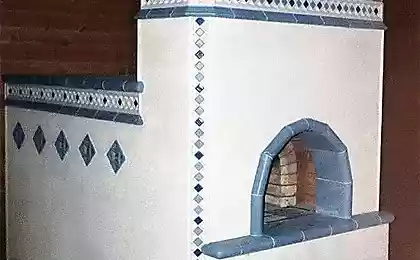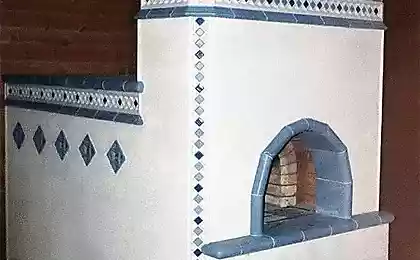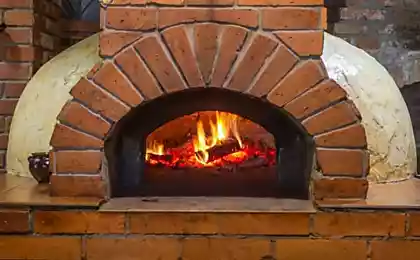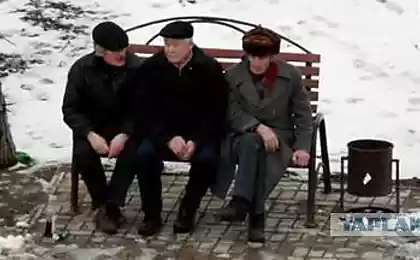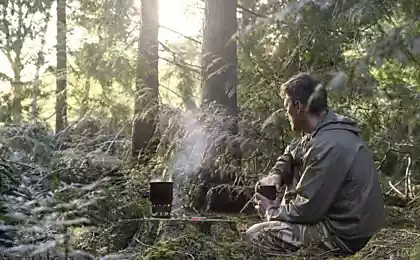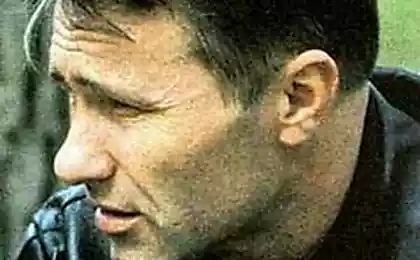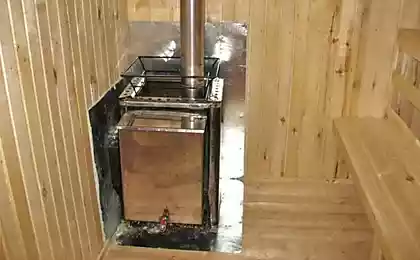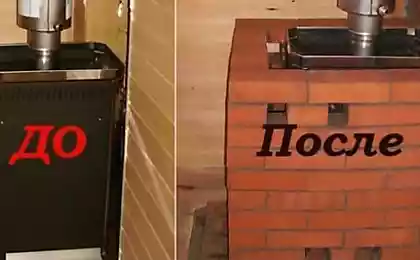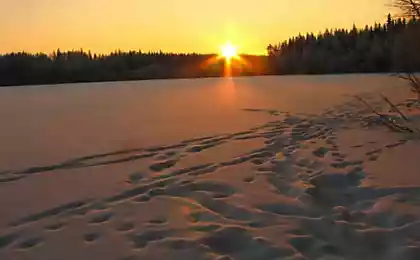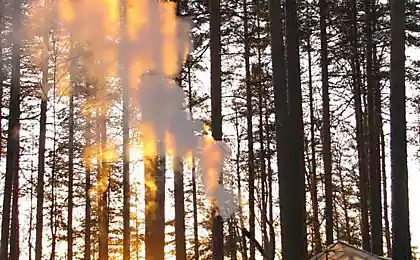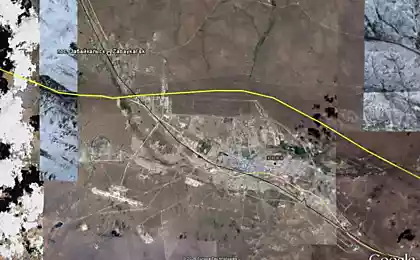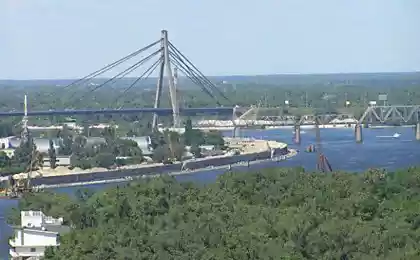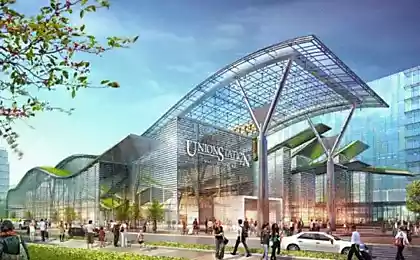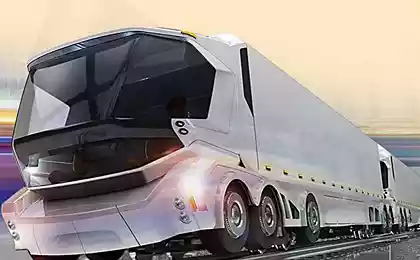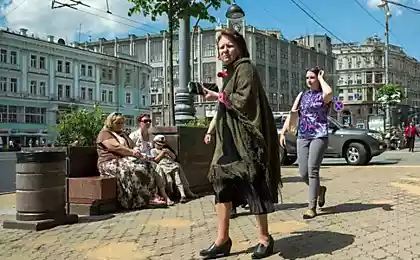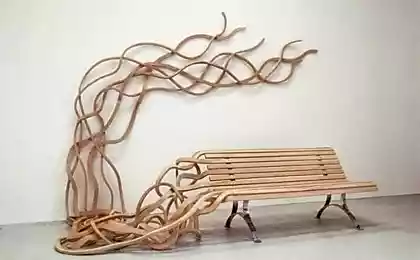966
Stove-shop: Railway perspective.
Quite a long time the film was selected to the genius Shukshina, and here this weekend to finally get to sit quietly and watch carefully, and then zaskrinshotit interesting. It's time to share with you found me.
We are talking about the film "Stove-Benches" (1972) and its railway component. And she it is huge - 95 minutes of the film 53, ie 56% of the content, filmed in the car. From 18 th to 71 th minute. A huge number of interesting details, picturesque Valais passengers, clothing and habits of those days. Much has been very different from that to which used contemporary 2010s.
57 pictures and author's comments
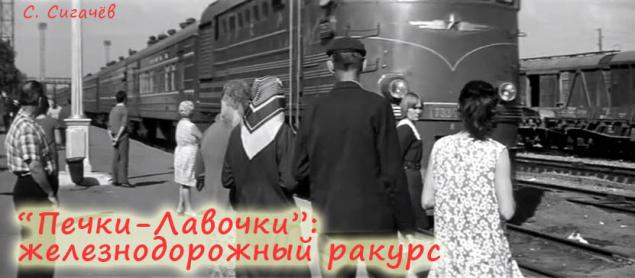
The film is interesting for two other unique features:
A) The shooting occurred before the onset of the so-called "Ammendorf era", that is the rule of the vast Soviet East German railway compartment cars have become in the technical history of our country the most adaptable and almost benchmark for mainstream multi day long distance communications, combined with the reasonable price of production. This era lasted nearly 30 years (1974-2004), but more about it at some later stage. For our theme, it is important that Shukshin put his characters in the most modern domestic production compartment car just before coming to the expanses of the Motherland 'Ammendorf'. Our kupeyniki lasted until about the mid-80s, and then massively left the scene, to tell of-life. So that the current viewer under forty "that" the car is hardly remembers.
B) Style Vasily Shukshin - shoot as much as possible a fair and close to reality, so it is much less likely to Riasanovsky gaydaevskim or replacements in the style of "extradite one after another in order to save time and budget stage." And that is why we face the situation where deployed and types is the "Siberian" train, rather than a "resort" ("capital - a resort") - How does the vast majority of his colleagues, his task easier. This film is important and valuable: the history, for example, was the station wagon and Biysk tamoshnego messages, captions and details from there, from Siberia. I am sure that the characters he spied his typecasting, most likely, in those parts. I myself learned many characters, they were common in those days.
I shall warn that it would consider in its analysis of only the w / d of the film, and I will not go beyond it. Parts and fix the moment it came out very much, so we had to partially reduce the scope. But even so it left about 120 screenshots, and I reluctantly shared all this in two parts. Let's see some logic techniques that used the director.
Something I did not understand; some items are not recognized - so write in the comments what can help and to clarify that the recall of the details. I think collectively we can reveal the mysteries of the remnants of the film. I'm concerned about the specifics in deciphering the canvas, so useless for the theme and srachery flooder be cleaned out - that normal updates with comments or questions are not lost in the mass.
1. Thus, the beginning of the railway (0-17-18): our heroes out of the keyway and the background is w / station. By fragment can accurately identify the station Biysk - a dead-end station on the line to art. Altai, to which 147 km from here. On Altai further there is a fork - to Barnaul and farther south meridional line of the Trans-Novosibirsk - Tomsk, Kemerovo region.
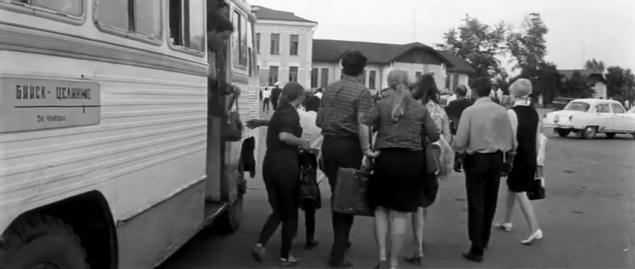
On the canvas of the film it turns out that Ivan took the ticket directly at the station - the ones that are available. That is, before the departure, they advance for a ticket did not go here, do not use pre-sale. Although Biysk - the last station and then pre-sold tickets to places for 1971-72. it really is.
2. Cash inside. To the right is clearly visible rack lined hard ticket with fixed stations and tariffs. The cashier took out the desired station from the shelves and quickly designed the sale, a ticket punching the current date. (But 0-18-41 appears blank paper ticket, which is made much longer and the rate cut with scissors)
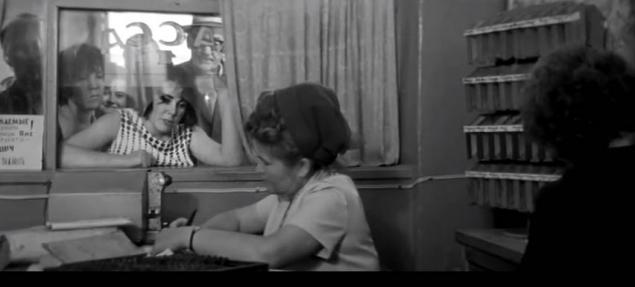
3. next to the cash register inside the window is classified "Dear passengers! We ask you during the cashier does not ask questions! ". This ad is most likely real and not props for the movie.
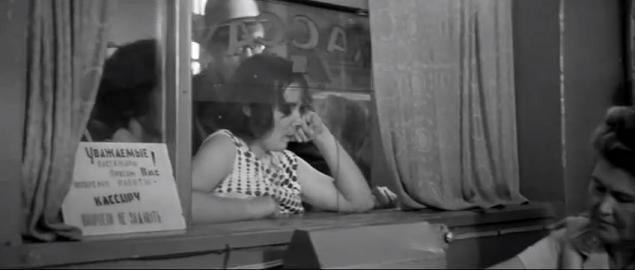
4. Railway station waiting room. The station is a dead-end, a relatively small station. Immediately visible and the entrance to the restaurant art. Biisk, and automatic storage chamber at the wall. Logo on the sign - the West Siberian railway, and now it is painted on the road electric locomotives, 40 years after the film's release. The windows are wide open to the platform. Note also widespread hats for men. But this is not the capital and not even obltsentr! Fashion was such.
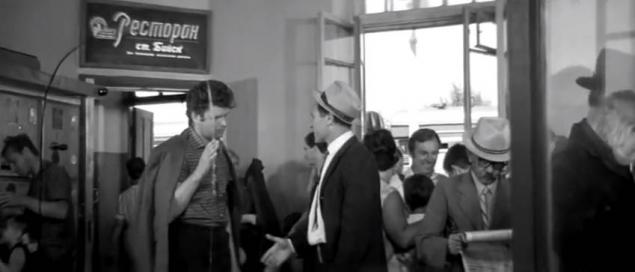
5. The sign of the times: all eating ice cream. Mass, from small to large. Cheap wafer cups of milk or cream honest - there was no food this terrible scam or chemicals, and therefore such popularity. The maximum that could be - partially melted glasses. And yet, see how colorful dresses are in female passengers at the station, the most unimaginable motley colors. The same sign of the times.
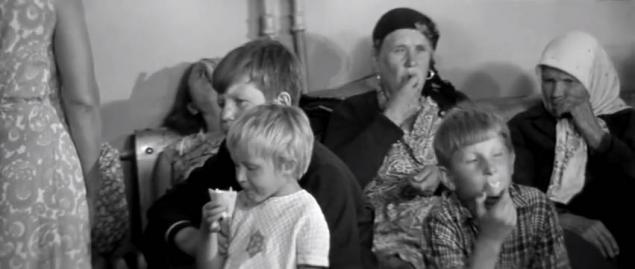
6. Finally, begin closer to the rail - the director shows us the car from a distance (0-18-51). The local, according to the AP on the side of the code. All honest filmed there. On the frame, there is already back, colorful type lean white-bearded grandfather with a suitcase, he playfully runs to the train. But just before the grandfather is shown with a person look. He is also wearing a hat in the fashion.
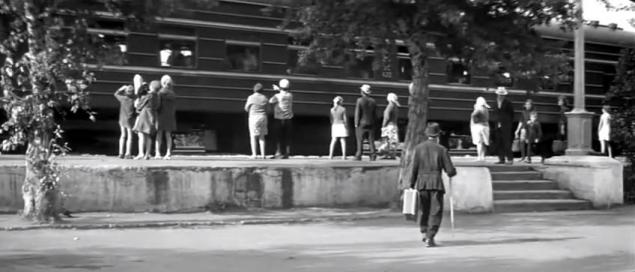
The action is transferred to the car. At first Ivan for greater importance it holds the paper (for the font and the title - such as "truth", but dates can not tell), but then enters into a conversation with a neighbor, obviously business travelers. Here SHukshin took classical type-Soviet intellectual nerds, gave him all the necessary attributes (hat zalysinki, ochochkah, didactic tone, arrogance, sarcasm) and excluded the individual - no doubt to the viewer in the image. This type here also barrator - this was not rare in Soviet times. Nowadays barrator transformed into a "legally savvy" and somewhat modified.
7. Sit in the compartment, the window in the passageway open. For Shukshin visible ladder to the top bunk.
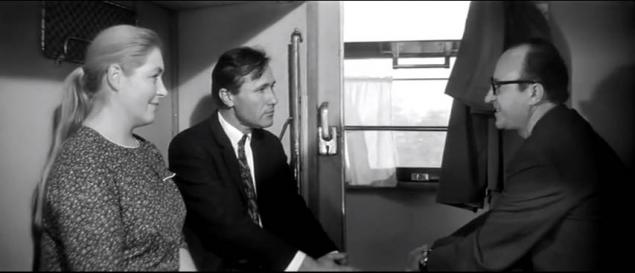
Once they got to the final station, the intellectual-barrator clearly not local. Perhaps one of Biysk supplier factories. Or maybe, Barnaul and Novosibirsk, and the worker - who came "into the wilderness" to solve issues with the subordinate enterprises. Here he came "dyarёvnya." It is curious that the dialogue directly take aggressive and didactic (from the "City") character. Usually among the fellow travelers on the train is not going right away - you need about half an hour on mutual probing; but here the compression action.
It appears conductor. Old, probably for life provodnichit. In the hands - 4 sets of underwear, two, he gives Ivan and Nura. His intellectual kit for some reason does not get. Maybe it goes far, for example, only to Barnaul?
8. "The bed will take?" - That is, you can not take it. Even in the compartment. Now you can not do, bedding included in the ticket price. In Soviet times - only separately.
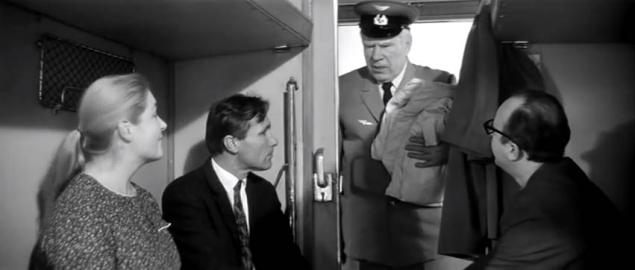
Ivan does not know that you need a separate bed for the money; Nura is holding money in her stocking - barrator finally convinced that in front of him, "rustic fuckers" who do not know the external reality, and you can show off with impunity. From the conversation turns to the same, that the 40-45-year-old man, obviously not so bad, and earning a very foldable speech edёt in the first long-distance trains (!!!) time in my life. Just a gift for barrator-intellectual!
9. Washing the hands of the conductor is made up of individual elements, issued to the passenger - then it was not sealed packages before that we have somehow guessed only in the mid-90s, when the "Kitaika" became sverhmassovym focus.
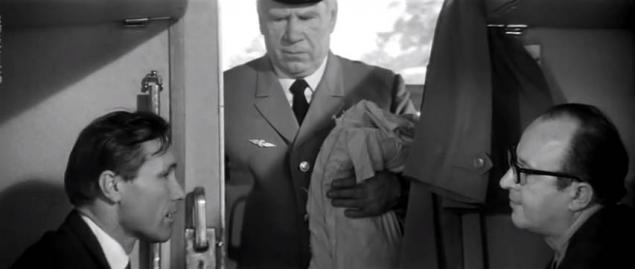
10. While there is a conversation with podkolochkami, passengers walk down the aisle at tea. Girl with empty glasses goes dial.
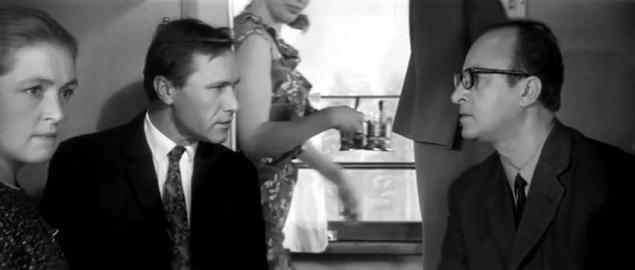
11. Another passenger carries already hot tea. The holder, Kolchuginsky types. Glasses thin negranёnye - are often fought.
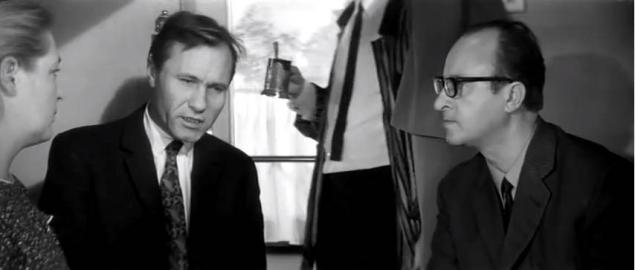
12. Dismantling of Ivan, the intellectual comes over. Explore the entire form, pinzhake, cap and insignia. The window in the passage is closed.
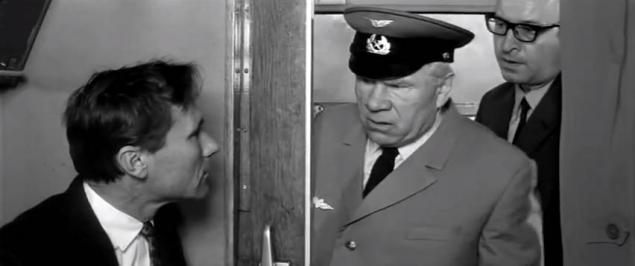
13. After a few moments, a window has miraculously opened
And intellectuals expressed in the frame well. Definitely Shukshin made this type with the generalization of the reference image - so ugly urban savvy barrator should look in the eyes of the viewer. "Profursetka pants and a hat!".
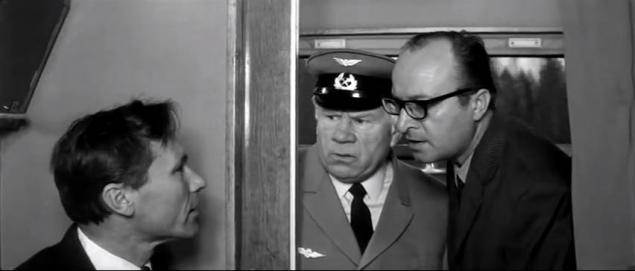
14. barrator runs away to seek justice on prinaglevshego village simpleton; along the way - the other conductor of the train. "Where is the senior conductor?". That is, in the car was a hierarchy - a senior and a normal conductor. The window is wide open.
And yes. Note the interior of the car, without wooden cross beams - doors smooth. Below you will see some scenes were shot later in another car.
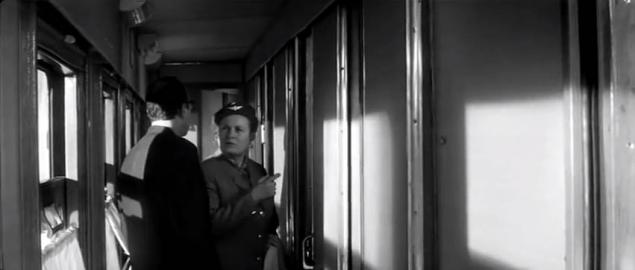
15. During our heroes - strong mesh for small items, with bar for towels.
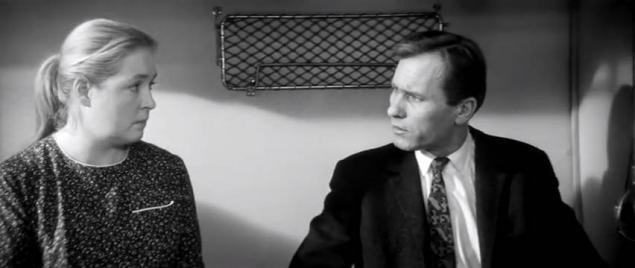
16. Coupe in volume. The table is small, on it - a thin glass with 2 rims. And - an ashtray, staff! How could pull off such a view, right on the wall - because the camera took a considerable place? Apparently, they did a hole from an adjacent compartment.
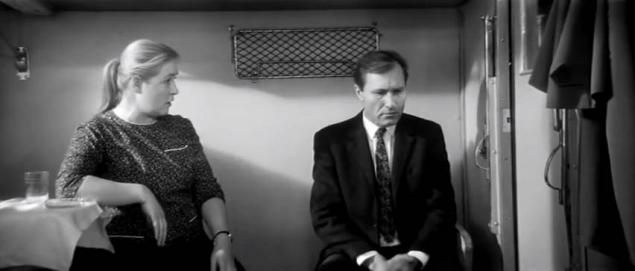
Finally, barrator moved into another compartment. It was just - because at the intermediate stations were not selling in a fixed position and the conductor could have varied spans of empty seats in the car as wanted. Just before the big stations such as Novosibirsk and Omsk, he gave a summary of the chief places of the train and he radioed radioed for sales for 1-2 hours at a station.
Getting to the next act.
After 24 minutes, it appears on the scene the most colorful character - Train "guest artists". Quite simply, a thief.
17. The guest artists Bourke is in the car from the nonworking vestibule, near the toilet. Apparently, he went to a nearby car, with the loot. It is free to smoke - it was not forbidden then inside the car.
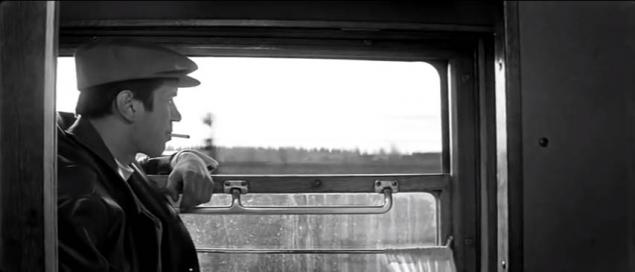
18. Driving electrified. But outside periodically and often even seen white smoke (0-23-32) - composition does not lead locomotive. Impossible to confuse. Some clearly haul locomotive, apparently under the P-36 or C (y). Ivan approaches and lights up both smoke for a sweet conversation.
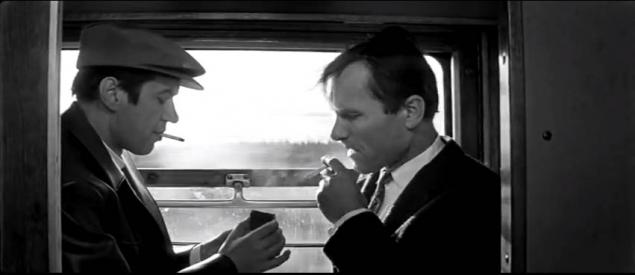
Initial dialogue Ivan and guest artists, Victor (0-23-40 onwards) is modeled Shukshin Workshop: clearly shows that Basil Kravchuk was well in the subject, such typecasting. Precise, very specific questions and a second lengthy discourse wanting to talk to after the stress. And I remember those. The first - a psychologist, and the second - a victim. However, this is not quite the victim - because Burkov with prey, and he just needed temporary shelter.
19. Introduction of the Nura. On Burkova - kozhzamovsky chic jacket squeak that time fashion. And vodolazochka (badlon in the St. Petersburg). In general, guest artists pretend to be "five."
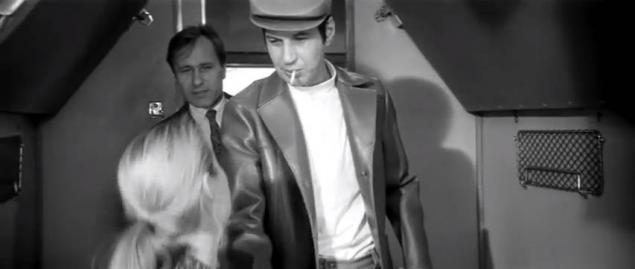
20. More views Burkovsky jacket from imitation leather.
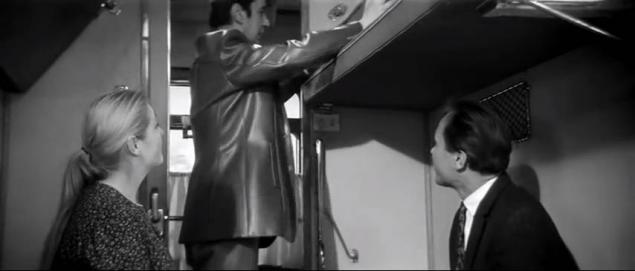
20a. Conductor brings tea. Kolchuginsky standard cup holders. In the relief, most likely, or Spasskaya Tower or satellite (not visible here). Burkov smokes.
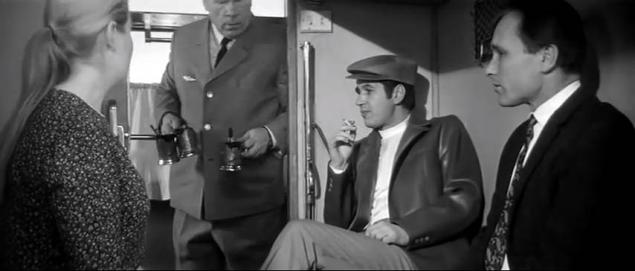
21. And now - please! On the frame is well visible contrast to the Soviet car from Ammendorf: if the GDR-ovtsev plastic was smooth, our car is almost always - with riflёnostyu on the cover. Come inside, and at the beginning of the passage of this corrugating unmistakably see that not Ammendorf.
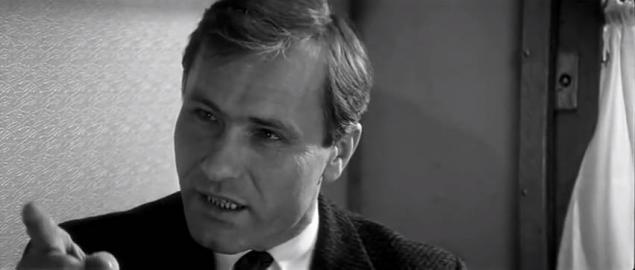
22. Conductor carries the tea wagon.
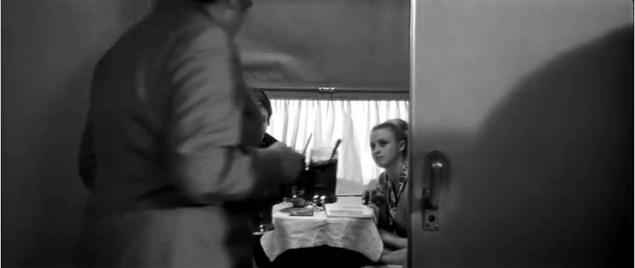
23. Talk to the compartment. Right inside the free-smoking, and on the table is nominally an ashtray. In Soviet times I remember that it often lacked until limited (about the end of the 80s).
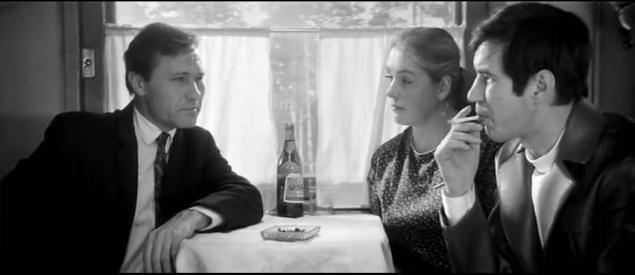
23a. Smoking in the compartment. No complex.
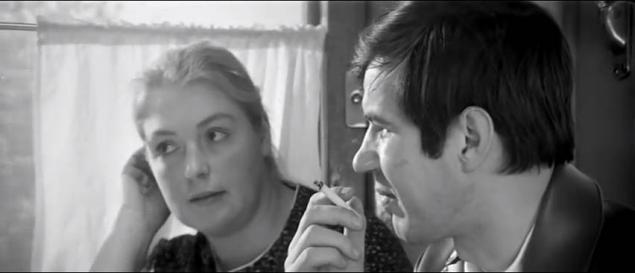
24. View chemodan- "prey." He also fashioned by the standards of the early 1970s - not hard fibreboard and semi-soft leatherette. So Burkov "took" it seems precisely as clearly more substantial and expensive production. We also see that in the compartment at the bottom of the Soviet was not yet a mini-lamps over the air passengers in Ammendorf.
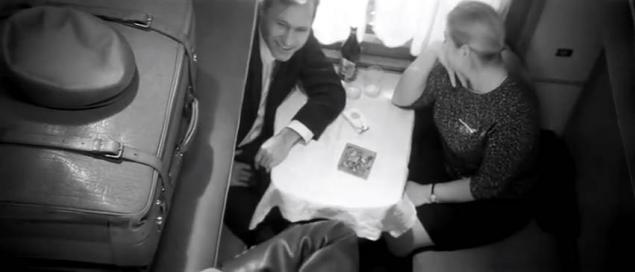
25. Printing suitcase. Top - incomprehensible to me unit (cigarette? Or what?) Tennyson. Visible as a chocolate bar "Alenka". And some pack on it. Cigarette? In the hands of Burkova - cognac KVVK. In principle, not bad.
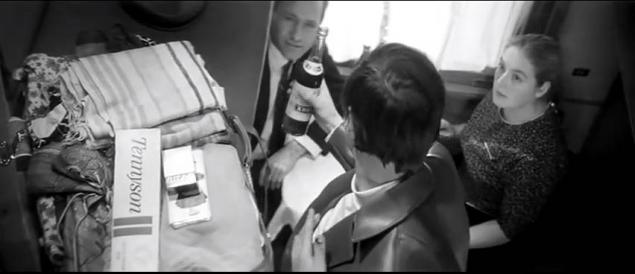
26. In the bag - a pack of gold pieces (see the "Lenin", but notes in black / white contrast look very means - no quarter-and dozens of reds). Option hundred fifty dollars or highly unlikely - at that time it was too much money.

26a. Suddenly found newfangled blouse made of synthetics! It is necessary to give, to strengthen relations with these simpletons and reliability of relations in temporary shelters.
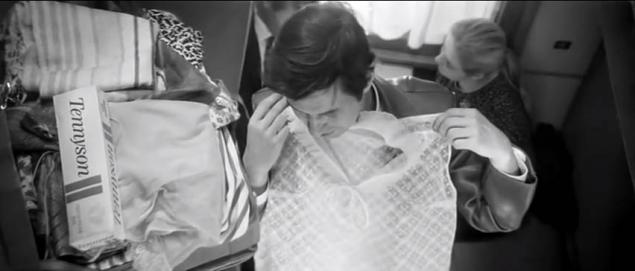
27. The two heroes, their right - light switch in the compartment. There's also, like, and shaver (?).
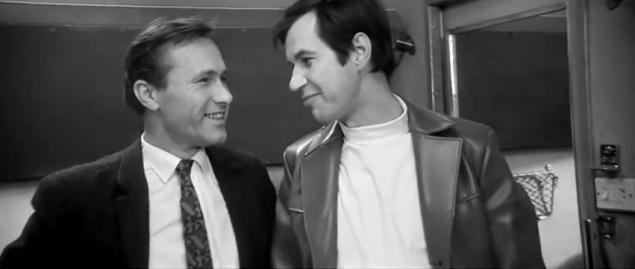
28. Nura - translucent blouse from some ostromodnye then artificial material. Now such quality has fallen into disuse, but the 60 th - first half of the '70s - the peak of fashion for synthetics.
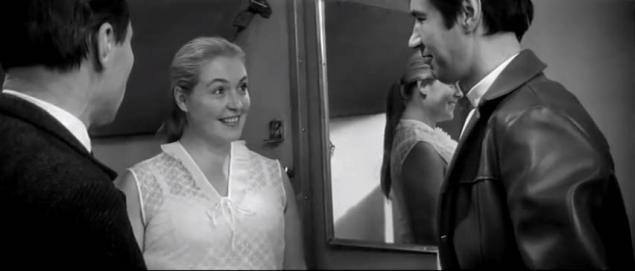
29. Here switch socket seen better than №27. Door coupe - with a mirror to the waist.
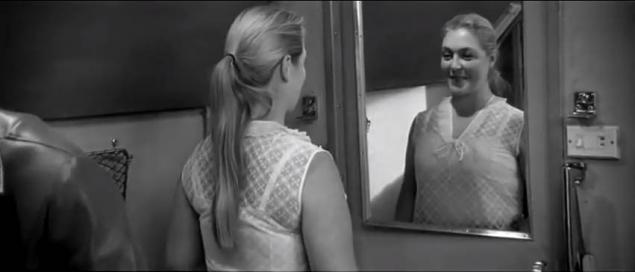
30. The guest artists "cures" village, recognizing a good, grateful for the object of talk time. Drink. Gradually - Burkov professional, and it itself controls, get drunk - not an end in itself. Cup with rims of podstakannikovogo explicitly set. This is less common and more often caught with three thin rims on top.
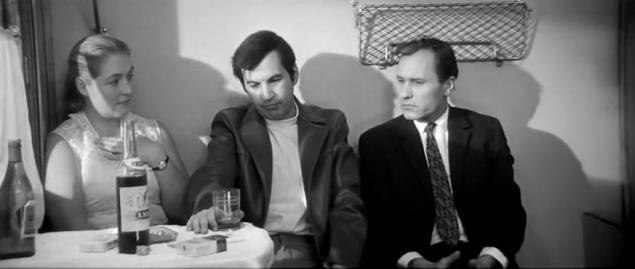
31. They came to the station (0-34-31). Nice view on the coupe.
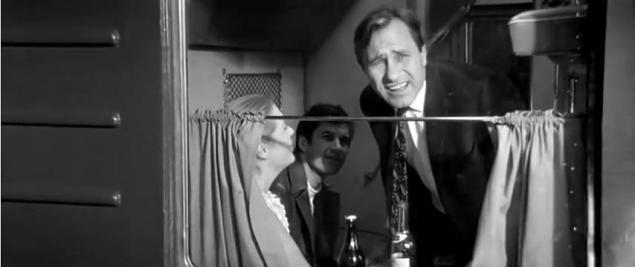
32. The station is visible in the depths of a barrel of kvas. Right on the station platform.
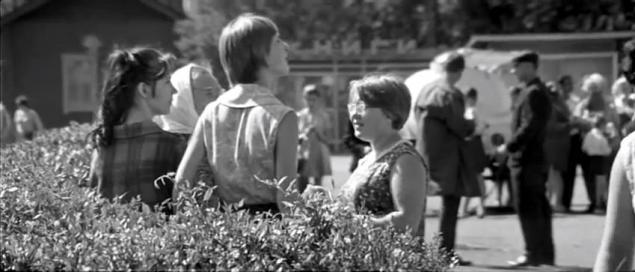
33. Interview with a police officer (the irrepressible barrator snitched, sensing a possible rematch if swells). The glasses of brandy poured roughly twice as much as in the №30.
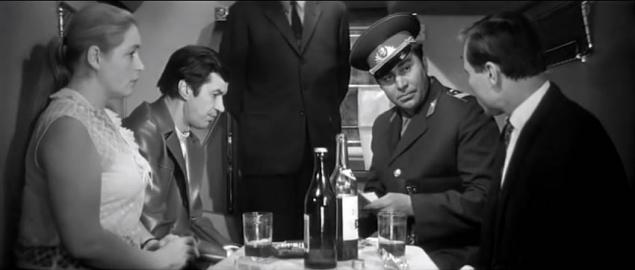
34. On a nearby path is too compartment car, top hanging string bag of apples.
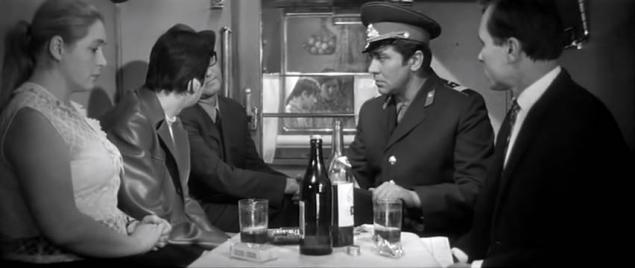
35. Clearly visible insignia and tabs with the arms at the senior police sergeant.

It should be noted that this conversation (with guest artists barrator in the presence of a policeman) SHukshin also delicately modeled. No false, absolutely. From the conversation it turns out that Burkov edёt allegedly "in Akademgorodok" - that is, the train goes on line in Barnaul, Novosibirsk, and then continue.
What is this plant? I do not know. Perhaps Altai. Or Barnaul, if there is to go there.
36. Here you can see that in the next car in the compartment smoke.
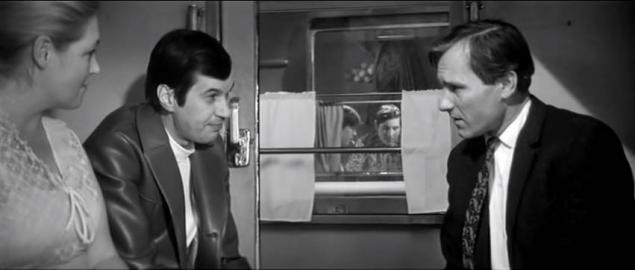
37. Excellent type of naive Soviet era, in the style of the early '70s, with sideburns. Look for the coupe at a company for preference (0-38-03). More used to the company searched for "a thousand." Guest artists of his kicks - nothing to distract!
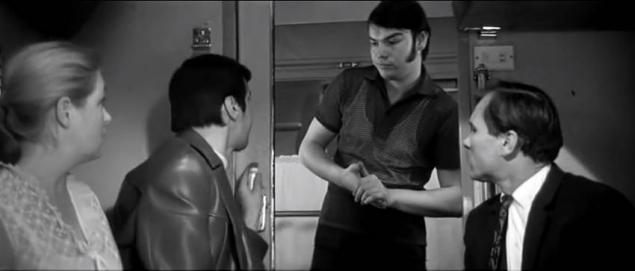
38. The end of the episode. "Aircraft Train bias" has decided to evacuate, sensing the smell of roasting. Leaves on the car in the direction of a nonworking vestibule.
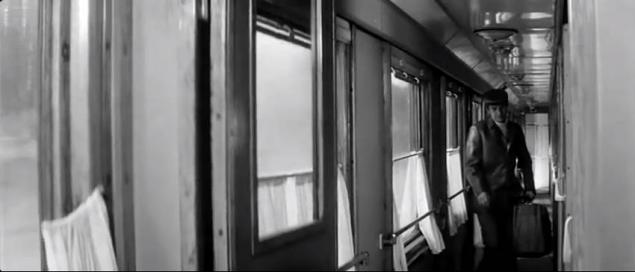
39. Open the door (0-39-48)! Inoperable. So, these doors were not closed. Later, in the 80s, they have always proactively closed at trehgranku.
Also seen here, the train goes under the locomotive - by part of the club of white smoke. Take a closer look. TE3 or "Masha" so did not smoke.
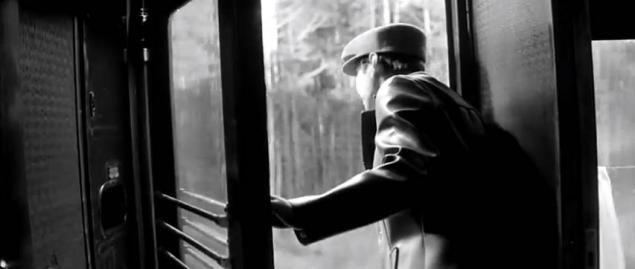
40. Tear the emergency brake, and leaves from the track (apparently). Braking is very sharp. See picture. Passengers are falling on each other.
Why would unmask itself so obviously I do not know. Perhaps it was easier to wait for the slow and just jump. And so, on the orientation and the exact place of braking it can quickly calculate. However, it may be that Shukshin decided to just dashing to force the plot.
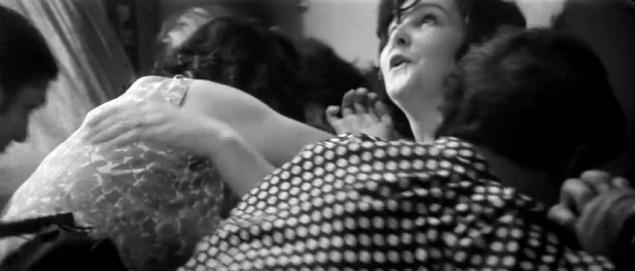
41. Chic types. Smoking directly on the shelf, of course
These will not flew from braking, and quietly watching from the open window on the situation. Note that the window opened by the standard even lower than is top shelf.
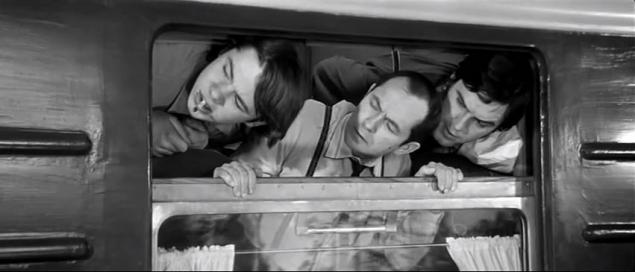
42. Again, the Soviet police. Same as on №33, and another.
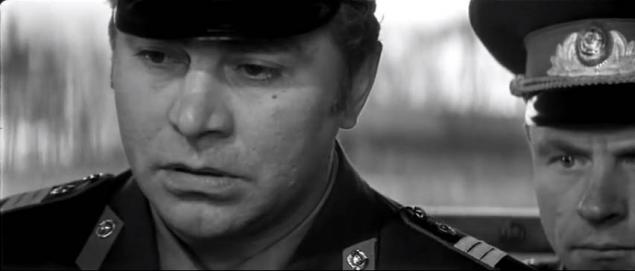
43. Interview with a police officer. Window half closed tight leather curtain. When Burkov left (№38), everything was open.
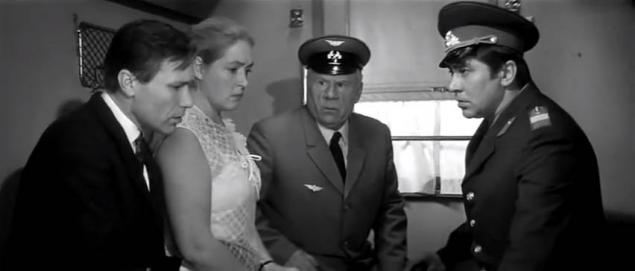
44. The most illogical scene in the film: the seasoned conductor recognized the village simpleton unknown passengers, already had time to myself any differently to show in this role, that he planted this guest artists without a ticket (0-41-21). In the real world, of course, the conductor for what it would not do, especially with such a huge work experience.
But apparently, the plot for peace Shukshina went for it. However, it is illogical.
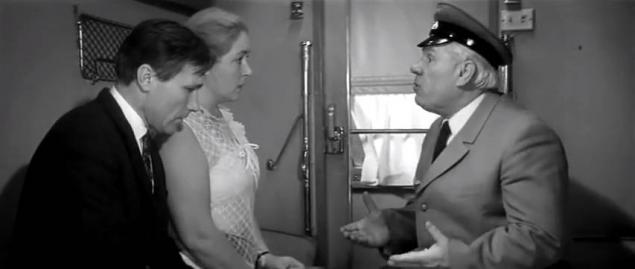
45. The conductor leaves the parting words "sit still" and a second window opens.
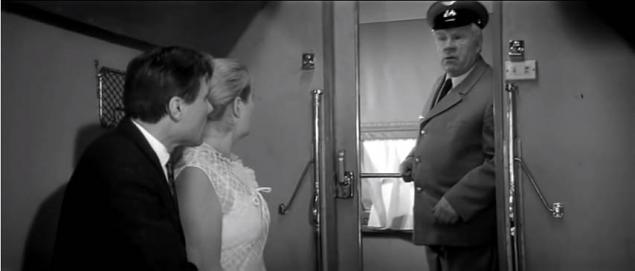
46. By the way, that there is a bottle of brandy around KVKK? Some lemonade? If someone can be identified by the label - write.
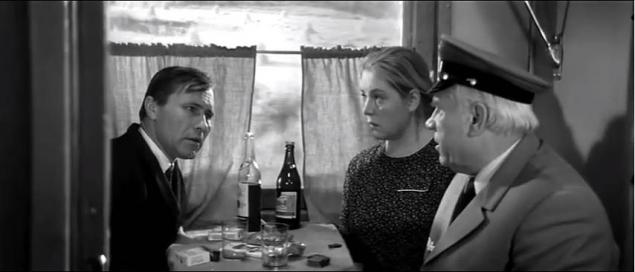
47. It can be seen that the conductor is not very clean at hand - accidentally tried to "grab" unowned scarce blouse. She remained with the factory label, though Nura has already vilified her and remove.
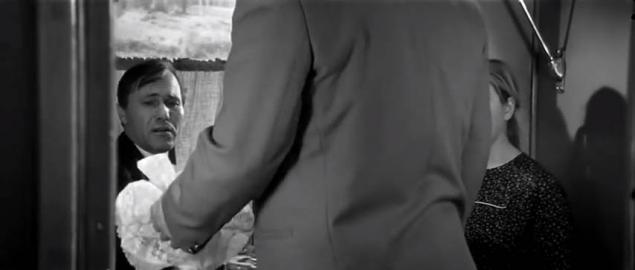
48. Ivan tries to get away with a blouse to the toilet from the duty room of the conductor, but the girl with a towel ahead of him. The car is then "clean" without the wooden beams.
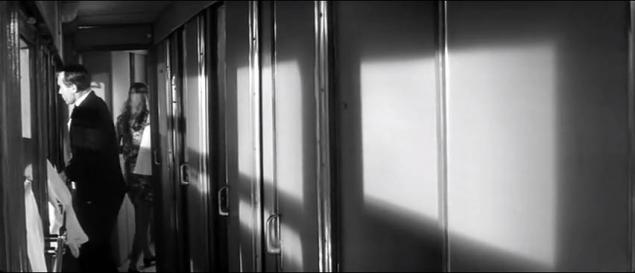
49. He goes back. Please note that titanium is closed, although the passengers constantly go for tea and its conductor also constantly throughout the film carries.
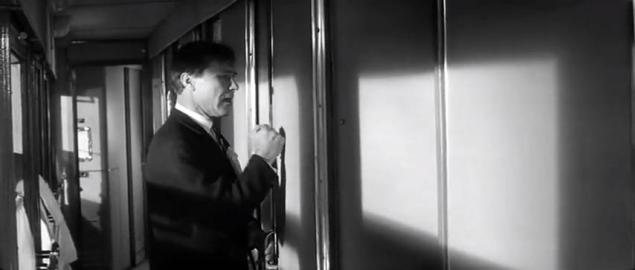
50. There is now back in the toilet with a broken hand.
Source:
We are talking about the film "Stove-Benches" (1972) and its railway component. And she it is huge - 95 minutes of the film 53, ie 56% of the content, filmed in the car. From 18 th to 71 th minute. A huge number of interesting details, picturesque Valais passengers, clothing and habits of those days. Much has been very different from that to which used contemporary 2010s.
57 pictures and author's comments

The film is interesting for two other unique features:
A) The shooting occurred before the onset of the so-called "Ammendorf era", that is the rule of the vast Soviet East German railway compartment cars have become in the technical history of our country the most adaptable and almost benchmark for mainstream multi day long distance communications, combined with the reasonable price of production. This era lasted nearly 30 years (1974-2004), but more about it at some later stage. For our theme, it is important that Shukshin put his characters in the most modern domestic production compartment car just before coming to the expanses of the Motherland 'Ammendorf'. Our kupeyniki lasted until about the mid-80s, and then massively left the scene, to tell of-life. So that the current viewer under forty "that" the car is hardly remembers.
B) Style Vasily Shukshin - shoot as much as possible a fair and close to reality, so it is much less likely to Riasanovsky gaydaevskim or replacements in the style of "extradite one after another in order to save time and budget stage." And that is why we face the situation where deployed and types is the "Siberian" train, rather than a "resort" ("capital - a resort") - How does the vast majority of his colleagues, his task easier. This film is important and valuable: the history, for example, was the station wagon and Biysk tamoshnego messages, captions and details from there, from Siberia. I am sure that the characters he spied his typecasting, most likely, in those parts. I myself learned many characters, they were common in those days.
I shall warn that it would consider in its analysis of only the w / d of the film, and I will not go beyond it. Parts and fix the moment it came out very much, so we had to partially reduce the scope. But even so it left about 120 screenshots, and I reluctantly shared all this in two parts. Let's see some logic techniques that used the director.
Something I did not understand; some items are not recognized - so write in the comments what can help and to clarify that the recall of the details. I think collectively we can reveal the mysteries of the remnants of the film. I'm concerned about the specifics in deciphering the canvas, so useless for the theme and srachery flooder be cleaned out - that normal updates with comments or questions are not lost in the mass.
1. Thus, the beginning of the railway (0-17-18): our heroes out of the keyway and the background is w / station. By fragment can accurately identify the station Biysk - a dead-end station on the line to art. Altai, to which 147 km from here. On Altai further there is a fork - to Barnaul and farther south meridional line of the Trans-Novosibirsk - Tomsk, Kemerovo region.

On the canvas of the film it turns out that Ivan took the ticket directly at the station - the ones that are available. That is, before the departure, they advance for a ticket did not go here, do not use pre-sale. Although Biysk - the last station and then pre-sold tickets to places for 1971-72. it really is.
2. Cash inside. To the right is clearly visible rack lined hard ticket with fixed stations and tariffs. The cashier took out the desired station from the shelves and quickly designed the sale, a ticket punching the current date. (But 0-18-41 appears blank paper ticket, which is made much longer and the rate cut with scissors)

3. next to the cash register inside the window is classified "Dear passengers! We ask you during the cashier does not ask questions! ". This ad is most likely real and not props for the movie.

4. Railway station waiting room. The station is a dead-end, a relatively small station. Immediately visible and the entrance to the restaurant art. Biisk, and automatic storage chamber at the wall. Logo on the sign - the West Siberian railway, and now it is painted on the road electric locomotives, 40 years after the film's release. The windows are wide open to the platform. Note also widespread hats for men. But this is not the capital and not even obltsentr! Fashion was such.

5. The sign of the times: all eating ice cream. Mass, from small to large. Cheap wafer cups of milk or cream honest - there was no food this terrible scam or chemicals, and therefore such popularity. The maximum that could be - partially melted glasses. And yet, see how colorful dresses are in female passengers at the station, the most unimaginable motley colors. The same sign of the times.

6. Finally, begin closer to the rail - the director shows us the car from a distance (0-18-51). The local, according to the AP on the side of the code. All honest filmed there. On the frame, there is already back, colorful type lean white-bearded grandfather with a suitcase, he playfully runs to the train. But just before the grandfather is shown with a person look. He is also wearing a hat in the fashion.

The action is transferred to the car. At first Ivan for greater importance it holds the paper (for the font and the title - such as "truth", but dates can not tell), but then enters into a conversation with a neighbor, obviously business travelers. Here SHukshin took classical type-Soviet intellectual nerds, gave him all the necessary attributes (hat zalysinki, ochochkah, didactic tone, arrogance, sarcasm) and excluded the individual - no doubt to the viewer in the image. This type here also barrator - this was not rare in Soviet times. Nowadays barrator transformed into a "legally savvy" and somewhat modified.
7. Sit in the compartment, the window in the passageway open. For Shukshin visible ladder to the top bunk.

Once they got to the final station, the intellectual-barrator clearly not local. Perhaps one of Biysk supplier factories. Or maybe, Barnaul and Novosibirsk, and the worker - who came "into the wilderness" to solve issues with the subordinate enterprises. Here he came "dyarёvnya." It is curious that the dialogue directly take aggressive and didactic (from the "City") character. Usually among the fellow travelers on the train is not going right away - you need about half an hour on mutual probing; but here the compression action.
It appears conductor. Old, probably for life provodnichit. In the hands - 4 sets of underwear, two, he gives Ivan and Nura. His intellectual kit for some reason does not get. Maybe it goes far, for example, only to Barnaul?
8. "The bed will take?" - That is, you can not take it. Even in the compartment. Now you can not do, bedding included in the ticket price. In Soviet times - only separately.

Ivan does not know that you need a separate bed for the money; Nura is holding money in her stocking - barrator finally convinced that in front of him, "rustic fuckers" who do not know the external reality, and you can show off with impunity. From the conversation turns to the same, that the 40-45-year-old man, obviously not so bad, and earning a very foldable speech edёt in the first long-distance trains (!!!) time in my life. Just a gift for barrator-intellectual!
9. Washing the hands of the conductor is made up of individual elements, issued to the passenger - then it was not sealed packages before that we have somehow guessed only in the mid-90s, when the "Kitaika" became sverhmassovym focus.

10. While there is a conversation with podkolochkami, passengers walk down the aisle at tea. Girl with empty glasses goes dial.

11. Another passenger carries already hot tea. The holder, Kolchuginsky types. Glasses thin negranёnye - are often fought.

12. Dismantling of Ivan, the intellectual comes over. Explore the entire form, pinzhake, cap and insignia. The window in the passage is closed.

13. After a few moments, a window has miraculously opened
And intellectuals expressed in the frame well. Definitely Shukshin made this type with the generalization of the reference image - so ugly urban savvy barrator should look in the eyes of the viewer. "Profursetka pants and a hat!".

14. barrator runs away to seek justice on prinaglevshego village simpleton; along the way - the other conductor of the train. "Where is the senior conductor?". That is, in the car was a hierarchy - a senior and a normal conductor. The window is wide open.
And yes. Note the interior of the car, without wooden cross beams - doors smooth. Below you will see some scenes were shot later in another car.

15. During our heroes - strong mesh for small items, with bar for towels.

16. Coupe in volume. The table is small, on it - a thin glass with 2 rims. And - an ashtray, staff! How could pull off such a view, right on the wall - because the camera took a considerable place? Apparently, they did a hole from an adjacent compartment.

Finally, barrator moved into another compartment. It was just - because at the intermediate stations were not selling in a fixed position and the conductor could have varied spans of empty seats in the car as wanted. Just before the big stations such as Novosibirsk and Omsk, he gave a summary of the chief places of the train and he radioed radioed for sales for 1-2 hours at a station.
Getting to the next act.
After 24 minutes, it appears on the scene the most colorful character - Train "guest artists". Quite simply, a thief.
17. The guest artists Bourke is in the car from the nonworking vestibule, near the toilet. Apparently, he went to a nearby car, with the loot. It is free to smoke - it was not forbidden then inside the car.

18. Driving electrified. But outside periodically and often even seen white smoke (0-23-32) - composition does not lead locomotive. Impossible to confuse. Some clearly haul locomotive, apparently under the P-36 or C (y). Ivan approaches and lights up both smoke for a sweet conversation.

Initial dialogue Ivan and guest artists, Victor (0-23-40 onwards) is modeled Shukshin Workshop: clearly shows that Basil Kravchuk was well in the subject, such typecasting. Precise, very specific questions and a second lengthy discourse wanting to talk to after the stress. And I remember those. The first - a psychologist, and the second - a victim. However, this is not quite the victim - because Burkov with prey, and he just needed temporary shelter.
19. Introduction of the Nura. On Burkova - kozhzamovsky chic jacket squeak that time fashion. And vodolazochka (badlon in the St. Petersburg). In general, guest artists pretend to be "five."

20. More views Burkovsky jacket from imitation leather.

20a. Conductor brings tea. Kolchuginsky standard cup holders. In the relief, most likely, or Spasskaya Tower or satellite (not visible here). Burkov smokes.

21. And now - please! On the frame is well visible contrast to the Soviet car from Ammendorf: if the GDR-ovtsev plastic was smooth, our car is almost always - with riflёnostyu on the cover. Come inside, and at the beginning of the passage of this corrugating unmistakably see that not Ammendorf.

22. Conductor carries the tea wagon.

23. Talk to the compartment. Right inside the free-smoking, and on the table is nominally an ashtray. In Soviet times I remember that it often lacked until limited (about the end of the 80s).

23a. Smoking in the compartment. No complex.

24. View chemodan- "prey." He also fashioned by the standards of the early 1970s - not hard fibreboard and semi-soft leatherette. So Burkov "took" it seems precisely as clearly more substantial and expensive production. We also see that in the compartment at the bottom of the Soviet was not yet a mini-lamps over the air passengers in Ammendorf.

25. Printing suitcase. Top - incomprehensible to me unit (cigarette? Or what?) Tennyson. Visible as a chocolate bar "Alenka". And some pack on it. Cigarette? In the hands of Burkova - cognac KVVK. In principle, not bad.

26. In the bag - a pack of gold pieces (see the "Lenin", but notes in black / white contrast look very means - no quarter-and dozens of reds). Option hundred fifty dollars or highly unlikely - at that time it was too much money.

26a. Suddenly found newfangled blouse made of synthetics! It is necessary to give, to strengthen relations with these simpletons and reliability of relations in temporary shelters.

27. The two heroes, their right - light switch in the compartment. There's also, like, and shaver (?).

28. Nura - translucent blouse from some ostromodnye then artificial material. Now such quality has fallen into disuse, but the 60 th - first half of the '70s - the peak of fashion for synthetics.

29. Here switch socket seen better than №27. Door coupe - with a mirror to the waist.

30. The guest artists "cures" village, recognizing a good, grateful for the object of talk time. Drink. Gradually - Burkov professional, and it itself controls, get drunk - not an end in itself. Cup with rims of podstakannikovogo explicitly set. This is less common and more often caught with three thin rims on top.

31. They came to the station (0-34-31). Nice view on the coupe.

32. The station is visible in the depths of a barrel of kvas. Right on the station platform.

33. Interview with a police officer (the irrepressible barrator snitched, sensing a possible rematch if swells). The glasses of brandy poured roughly twice as much as in the №30.

34. On a nearby path is too compartment car, top hanging string bag of apples.

35. Clearly visible insignia and tabs with the arms at the senior police sergeant.

It should be noted that this conversation (with guest artists barrator in the presence of a policeman) SHukshin also delicately modeled. No false, absolutely. From the conversation it turns out that Burkov edёt allegedly "in Akademgorodok" - that is, the train goes on line in Barnaul, Novosibirsk, and then continue.
What is this plant? I do not know. Perhaps Altai. Or Barnaul, if there is to go there.
36. Here you can see that in the next car in the compartment smoke.

37. Excellent type of naive Soviet era, in the style of the early '70s, with sideburns. Look for the coupe at a company for preference (0-38-03). More used to the company searched for "a thousand." Guest artists of his kicks - nothing to distract!

38. The end of the episode. "Aircraft Train bias" has decided to evacuate, sensing the smell of roasting. Leaves on the car in the direction of a nonworking vestibule.

39. Open the door (0-39-48)! Inoperable. So, these doors were not closed. Later, in the 80s, they have always proactively closed at trehgranku.
Also seen here, the train goes under the locomotive - by part of the club of white smoke. Take a closer look. TE3 or "Masha" so did not smoke.

40. Tear the emergency brake, and leaves from the track (apparently). Braking is very sharp. See picture. Passengers are falling on each other.
Why would unmask itself so obviously I do not know. Perhaps it was easier to wait for the slow and just jump. And so, on the orientation and the exact place of braking it can quickly calculate. However, it may be that Shukshin decided to just dashing to force the plot.

41. Chic types. Smoking directly on the shelf, of course
These will not flew from braking, and quietly watching from the open window on the situation. Note that the window opened by the standard even lower than is top shelf.

42. Again, the Soviet police. Same as on №33, and another.

43. Interview with a police officer. Window half closed tight leather curtain. When Burkov left (№38), everything was open.

44. The most illogical scene in the film: the seasoned conductor recognized the village simpleton unknown passengers, already had time to myself any differently to show in this role, that he planted this guest artists without a ticket (0-41-21). In the real world, of course, the conductor for what it would not do, especially with such a huge work experience.
But apparently, the plot for peace Shukshina went for it. However, it is illogical.

45. The conductor leaves the parting words "sit still" and a second window opens.

46. By the way, that there is a bottle of brandy around KVKK? Some lemonade? If someone can be identified by the label - write.

47. It can be seen that the conductor is not very clean at hand - accidentally tried to "grab" unowned scarce blouse. She remained with the factory label, though Nura has already vilified her and remove.

48. Ivan tries to get away with a blouse to the toilet from the duty room of the conductor, but the girl with a towel ahead of him. The car is then "clean" without the wooden beams.

49. He goes back. Please note that titanium is closed, although the passengers constantly go for tea and its conductor also constantly throughout the film carries.

50. There is now back in the toilet with a broken hand.
Source:



